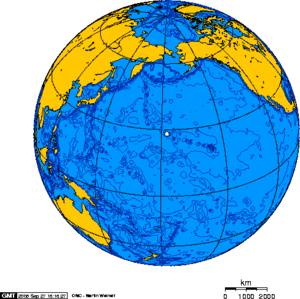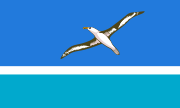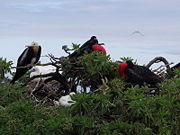Midway Atoll


Midway Atoll (or Midway Island or Midway Islands, pronounced /ˈmɪdweɪ/; Hawaiian: Pihemanu Kauihelani [1]) is a 2.4 square mile (6.2 km²) atoll located in the North Pacific Ocean (near the northwestern end of the Hawaiian archipelago), about one-third of the way between Honolulu and Tokyo. The Midway Atoll is owned by the USA. It is less than 140 nautical miles (259 km/161 mi) east of the International Date Line, about 2,800 nautical miles (5,200 km/3,200 mi) west of San Francisco and 2,200 nautical miles (4,100 km/2,500 mi) east of Tokyo. It consists of a ring-shaped barrier reef and several sand islets. The two significant pieces of land, Sand Island and Eastern Island, provide habitat for hundreds of thousands of seabirds. The island sizes are shown here:
| Island | acres | hectares | |||||||
|---|---|---|---|---|---|---|---|---|---|
| Sand Island | 1,200 | 486 | |||||||
| Eastern Island | 334 | 135 | |||||||
| Spit Island | 6 | 2 | |||||||
| Sand Islet | |||||||||
| Midway Atoll | 1,540 | 623 | |||||||
| Lagoon | 14,800 | 6,000 | |||||||
According to other sources, Sand Island measures 1,250 acres (5.1 km2) in area and the lagoon within the fringing rim of coral reef 9,900 acres (40 km2). The atoll, which has a small population (40 in 2004, but no indigenous inhabitants), is an unincorporated territory of the United States, designated an insular area under the authority of the U.S. Department of the Interior. It is a National Wildlife Refuge administered by the U.S. Fish and Wildlife Service (FWS). The visitor program reopened in January 2008 and there are facilities at the present time for receiving visitors. Currently the best way to travel to the Atoll is through a non-profit marine conservation organization based in San Francisco, Oceanic Society. They offer week long naturalist led tours focused on the ecology of Midway and the military history. The economy is derived solely from governmental sources and tourist fees. All food and manufactured goods must be imported.
Midway, as its name suggests, lies nearly halfway between North America and Asia, and halfway around the world from Greenwich, England. For statistical purposes, Midway is grouped as one of the United States Minor Outlying Islands.
Midway is best known as the location of the Battle of Midway, fought in World War II on June 4, 1942. Nearby, the United States Navy defeated a Japanese attack against the Midway Islands, marking a turning point in the war in the Pacific Theater.
Contents |
Geography and geology
Midway Atoll is part of a chain of volcanic islands, atolls, and seamounts extending from Hawai'i up to the tip of the Aleutian Islands and known as the Hawaii-Emperor chain. Midway was formed roughly 28 million years ago when the seabed underneath it was over the same hotspot from which the Island of Hawai'i is now being formed. In fact, Midway was once a shield volcano perhaps as large as the island of Lana'i. As the volcano piled up lava flows building the island, its weight depressed the crust and the island slowly subsided over a period of millions of years, a process known as isostatic adjustment. As the island subsided, a coral reef around the former volcanic island was able to maintain itself near sea level by growing upwards. That reef is now over 516 feet (160 m) thick (Ladd, Tracey, & Gross, 1967; in the lagoon, 1,261 ft (384 m), comprised mostly post-Miocene limestones with a layer of upper Miocene (Tertiary g) sediments and lower Miocene (Tertiary e) limestones at the bottom overlying the basalts. What remains today is a shallow water atoll about 6 miles (10 km) across.
The atoll has some 20 miles (32 km) of roads, 4.8 miles (7.8 km) of pipelines, one port (on Sand Island), and one active runway (rwy 06/24, around 8,000 ft (2,400 m) long). As of 2004, Henderson Field airfield at Midway Atoll has been designated as an emergency diversion airport for aircraft flying under ETOPS rules. The FWS closed all airport operations on November 22, 2004. Public access to the island was restored beginning March 2008.[2]
Uniquely among the Hawaiian islands, Midway observes UTC-11, eleven hours behind Coordinated Universal Time.
History
Nineteenth century

The atoll was discovered July 5, 1859 by Captain N.C. Middlebrooks, though he was most commonly known as Captain Brooks, of the sealing ship Gambia. The islands were named the "Middlebrook Islands" or the "Brook Islands". Brooks claimed Midway for the United States under the Guano Islands Act of 1856, which authorized Americans to temporarily occupy uninhabited islands to obtain guano. On August 28, 1867, Captain William Reynolds of the USS Lackawanna formally took possession of the atoll for the United States; the name changed to "Midway" some time after this. On August 28, 1867 the atoll became the first offshore islands annexed by the U.S. government, as the Unincorporated Territory of Midway Island; administered by the U.S. Navy. Midway was the only island in the entire Hawaiian archipelago that was not later part of the State of Hawaii.
The first attempt at "settlement" was in 1871, when the Pacific Mail and Steamship Company started a project of blasting and dredging a ship channel through the reef to the lagoon using money put up by the U.S. Congress. The purpose was to establish a mid-ocean coaling station avoiding the high taxes imposed at ports controlled by the Hawaiians. The project was shortly a complete failure, and the USS Saginaw, evacuating the last of the channel project's work force in October 1871, then ran aground at Kure Atoll, stranding all aboard. (All aboard were rescued with the exception of four out of the five men who drowned in an attempt to sail to Hawaii in an open boat to seek help. The party reached Kauai, but the boat was overturned just offshore and only William Halford survived and was able to bring help to the stranded).
Early twentieth century

In 1903, workers for the Commercial Pacific Cable Company took up residence on the island as part of the effort to lay a trans-Pacific telegraph cable. These workers introduced many non-native species to the island, including the canary, cycad palm, Norfolk Island pine, ironwood, coconut, and various deciduous trees, along with ants, cockroaches, termites, centipedes, and countless others.
Later that year, President Theodore Roosevelt placed the atoll under the control of the U.S. Navy, which on January 20, 1903 opened a radio station, in response to complaints from cable company workers about Japanese squatters and poachers. In 1904–1908 Roosevelt sent 21 U.S. Marines to stop the wanton destruction of bird life by Japanese poachers, and to keep Midway safe as a U.S. possession, protecting the cable station.
In 1935, operations began for the China Clippers, flying boats operated by Pan American Airlines. The Clipper island-hopped from San Francisco to China, providing the fastest and most luxurious route to the Orient and bringing tourists to Midway until 1941. Only the extremely wealthy could afford a Clipper trip, which in the 1930s cost more than three times the annual salary of an average American. With Midway on the route between Honolulu and Wake Island, the seaplanes landed in the atoll and pulled up to a float offshore. Tourists transferred to a small powerboat that ferried them to a pier, then ride in "woody" wagons to the Pan Am Hotel or the "Gooneyville Lodge", named after the ubiquitous "Gooney birds" (albatrosses).
World War II

The location of Midway in the Pacific became important to the military. Midway was a convenient refueling stop on transpacific flights, and was also an important stop for Navy ships. Beginning in 1940, as tensions with the Japanese were rising, Midway was deemed second only to Pearl Harbor in importance to protecting the U.S. west coast. Airstrips, gun emplacements and a seaplane base quickly materialized on the tiny atoll. The channel was widened, and Naval Air Station Midway was completed. Architect Albert Kahn designed the Officer's quarters, the mall and several other hangars and buildings. Midway's importance to the U.S. was brought into focus on December 7, 1941 with the Japanese attack on Pearl Harbor. Six months later, on June 4, 1942, a naval battle near Midway resulted in the U.S. Navy exacting a devastating defeat of the Japanese Navy. This Battle of Midway was, by most accounts, the beginning of the end of the Japanese Navy's control of the Pacific Ocean. Midway was also an important submarine base.
Korean and Vietnam Wars
From August 1, 1941 to 1945 it was occupied by U.S. military forces. In 1950, the Navy decommissioned Naval Air Station Midway, only to re-commission it again to support the Korean War. Thousands of troops on ships and planes stopped at Midway for refueling and emergency repairs. From 1968 to September 10, 1993 Midway Island was a Navy Air Facility. During the Cold War, the U.S. established an underwater listening post at Midway to track Soviet submarines. The facility remained secret until its demolition at the end of the Cold War. "Willy Victor" radar planes flew night and day as an extension of the DEW Line (Distant Early Warning Line), and antenna fields covered the islands.
With about 3,500 people living on Sand Island, Midway also supported the U.S. troops during the Vietnam War. In June 1969, President Richard Nixon held a secret meeting with South Vietnamese President Nguyen Van Thieu at the Officer-in-Charge house or "Midway House".
Civilian rule



In 1978, the Navy downgraded Midway from a Naval Air Station to a Naval Air Facility and large numbers of personnel and dependents began leaving the island. With the conflict in Vietnam over, and with the introduction of reconnaissance satellites and nuclear submarines, Midway's significance to US-national security was diminished. The World War II facilities at Sand and Eastern Islands were listed on the National Register of Historic Places on May 28, 1987.
Midway was designated an overlay National Wildlife Refuge on April 22, 1988 while still under the primary jurisdiction of the Navy. As part of the Base Realignment and Closure process, the Navy facility on Midway has been operationally closed since September 10, 1993, although the Navy assumed responsibility for cleaning up environmental contamination at Naval Air Facility Midway Island.
Beginning August 7, 1996, the general public could visit the atoll through study ecotours.[3] This program ended in 2002,[4] but another visitor program was approved beginning March 2008.[2][5]
On October 31, 1996, President Bill Clinton signed Executive Order 13022, which transferred the jurisdiction and control of the atoll to the U.S. Department of the Interior. The Fish and Wildlife Service assumed management of the Midway Atoll National Wildlife Refuge. The last contingent of Navy personnel left Midway on June 30, 1997 after an ambitious environmental cleanup program was completed.
On June 15, 2006, President George W. Bush designated the Northwestern Hawaiian Islands as a national monument. The Northwestern Hawaiian Islands Marine National Monument encompasses 105,564 square nautical miles (137,797 sq mi/356,893 km2), and includes 3,910 square nautical miles (5,178 sq mi/13,411 km2) of coral reef habitat.[6] The Monument also includes the Hawaiian Island Reservation established by Theodore Roosevelt in 1909, the Hawaiian Islands National Wildlife Refuge, and the Midway Atoll National Wildlife Refuge.
In 2007, the Monument's name was changed to Papahānaumokuākea (pronounced PA-pa-ha-NOW-mo-KUH-ah-KAY-uh) Marine National Monument.[7] The National Monument is managed by the U.S. Fish and Wildlife Service and the National Oceanic and Atmospheric Administration (NOAA), in close coordination with the State of Hawaii.
Wildlife

Birds native to other Northwestern Hawaiian Islands, such as the Laysan Rail and Laysan Finch, were released at Midway. Midway Atoll is now home to seventy-three percent of the worlds Laysan Albatross population, and thirty-five percent of the global black-footed albatross.[8]

Ironwood trees from Australia were planted to act as windbreaks. Seventy-five percent of the 200 species of plants on Midway were introduced. The FWS has recently continued this trend by introducing the Laysan duck to the island, while at the same time extending efforts to exterminate other introduced species.
Environmental issues

The islands of Midway Atoll have been extensively altered as a result of human habitation. Starting in 1869 with a project to blast the reefs and create a port on Sand Island, the ecology of Midway has been changing.
Marine debris
Midway Atoll, in common with all the Hawaiian Islands, receives substantial amounts of debris from the Great Pacific Garbage Patch. Consisting of ninety percent plastic, this debris accumulates on the beaches of Midway. This garbage represents a hazard to the bird population of the island.
Of the 2 million Laysan Albatrosses which inhabit Midway, nearly all are found to have plastic in their digestive system. Approximately one-third of the chicks die from ingestion of this plastic.[9]
Lead poisoning
Lead paint on the buildings still poses an environmental hazard to the albatross poplulation of the island. The the cost of stripping the paint is estimated to be $5 million.[10]
Transport
The usual method of reaching Sand Island, Midway Atoll's only populated island, is via Henderson Field Airport.
See also
- The Wrecker is an 1892 novel by Robert Louis Stevenson set on Midway.
Notes
- ↑ http://whc.unesco.org/uploads/pages/documents/document-136-1.pdf
- ↑ 2.0 2.1 "Midway Atoll Program to Reopen in March". United States Fish and Wildlife Service (January 11, 2008). Retrieved on 2008-01-20.
- ↑ "Study Tours of Midway Island". New York Times (July 7, 1996). Retrieved on 2007-09-16.
- ↑ Pandion Systems, Inc. (April 12, 2005). "Midway Atoll National Wildlife Refuge: Visitor program market analysis and feasibility study". United States Fish and Wildlife Service. Retrieved on 2007-09-16. (Page 1).
- ↑ "Interim Visitor Services Plan Approved". United States Fish and Wildlife Service (December 8, 2006). Retrieved on 2007-09-16.
- ↑ Questions and Answers About the Northwestern Hawaiian Islands Marine National Monument
- ↑ "Papahānaumokuākea: A Sacred Name, A Sacred Place". Retrieved on 2008-03-29.
- ↑ http://the.honoluluadvertiser.com/article/2005/Jan/17/ln/ln23p.html
- ↑ http://news.bbc.co.uk/2/hi/talking_point/7318837.stm
- ↑ Elizabeth Shogren (December 29, 2006). "Midway, a Protected Area, Is Also Underfunded". Retrieved on 2007-09-16.
References
- Ladd, H.S., J.I. Tracey Jr., and M.G. Gross. 1967. Drilling at Midway Atoll. Science, 156(3778): 1088–1095 (May 26, 1967).
External links
- AirNav - Henderson Field Airport : Airport facilities and navigational aids.
- Diary from the middle of nowhere BBC's environment correspondent David Shukman reports on the threat of plastic rubbish drifting in the North Pacific Gyre to Midway. Accessed 2008-03-26.
- Midway Atoll travel guide from Wikitravel
- Midway Atoll National Wildlife Refuge (this article incorporated some content from this public domain site)
- NOAA Midway Island Hawaiian Monk Seal Captive Care & Release Project
- The Battle of Midway: Turning the Tide in the Pacific, a National Park Service Teaching with Historic Places (TwHP) lesson plan
- Aviation: From Sand Dunes to Sonic Booms, a National Park Service Discover Our Shared Heritage Travel Itinerary
- Past residents of Midway Discussion of Midway related topics by former residents and those interested in Midway.
- U.S. Unincorporated Possessions. Accessed 2008-03-26.
- Where the Gooney Birds Are
|
||||||||||||||
|
||||||||||||||
|
|||||